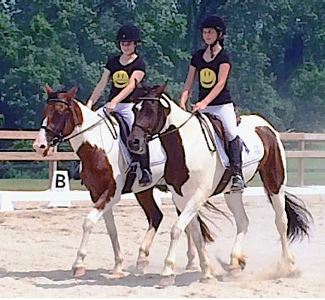Pas de Deux
Pas de Deux combines the elegance and impact of dressage musical freestyle with the added element of two horses and riders performing together. Competitive Pas de Deux must include movements and figures choreographed to meet the technical requirements of the particular level with music chosen to highlight the pair. Pas de Deux has great spectator and audience appeal due to the increased dynamic of two horses and riders dancing in the arena.
Pas de Deux is not only for competition. There are occasions where it becomes a feature attraction at a luncheon, special event, charity function, or demonstration at a show. In these cases, the rules may be put aside and more festive attitude taken. Music may reflect the season, event, or may be chosen to echo the particular team. At these affairs, costuming may even be used to express the music and ride, as well as added to the entertainment value.
Pas de Deux has great spectator and audience appeal. Making it a tremendous benefit to the promotion of the sport of dressage.
Questions? Email [email protected].

Unlike musical freestyle, there is no eligibility requirement for entering and competing in Pas de Deux. If the horses are not the same level, the lower level horse determines which level the team may enter as determined by USEF rules. The upper level horse is exempt from the two consecutive level rule. For example, a Prix St. Georges horse and Third Level horse may enter pas de deux competition no lower than Second Level.
The horse and rider combinations should be secure in the execution of all the technical requirements for the level they choose to show. The greater the team's command of the required elements, the more successful they are likely to be in timing the choreography to the music.
It is first necessary to be familiar with the score sheet as well as the rules. Because the quality of execution is judged as a whole, the same score sheet is used for all competitive levels from Training through Grand Prix. International Pas de Deux competition is under the jurisdiction of the FEI and uses the Freestyle score sheet from the same level. The score sheet is available through the link at the top of this page. Once you have chosen the level you wish to compete and have all your information at hand, you are ready to start.
The technical requirements of each level reflect the training and balance expected in the compulsory tests at that level. Technical Execution affects fifty percent of the total score, revealing the need for competence and ease in the execution of the movements. In Pas de Deux, the compulsory elements are judged as: Performance as a Pair (spacing, alignment, synchrony), Technical Execution, Gaits, Impulsion, and Submission. Compulsory movements are not scored individually, but are taken as a whole, thus emphasizing the need for solid technical execution.
Artistic Impression is the remaining fifty percent of the score and is comprised of Harmony Between Horses and Riders, Choreography, Music, and Interpretation.
The choreography must incorporate all the technical requirements listed on the score sheet for the level the team has declared. All requires elements must be done by both horses.
Choreography includes: balance, creativity, difficulty, and construction (design). Pas de Deux offers the opportunity for horses and riders to dance side by side, and or as mirror images, and or in-line as in follow the leader. These variations can all be incorporated into the choreography, adding dimension and visual appeal to both judges and spectators. Good choreography flows from one movement to the next with the music; utilizing the whole arena, and demonstrating the ease of the side-by-side, mirror images, and in-line variations.
Music selection should serve to accentuate the two horse and rider pairs. Matching strict tempo to both horses is not required. The music chosen must suggest the gait, and provide musical phrasing that can be interpreted through choreography. Does the musical phrase sound like a ten-meter circle? Does it sound like a leg yield or a half pass? Music for Pas de Deux is a wellspring of choices: classical, rock, jazz, pop, Broadway, soundtracks, even vocals. Just as in musical freestyles, maintaining a theme throughout is paramount. It is important to stay within the same musical genre. Using jazz for the trot and rock for the canter is jarring for both judges and audience. Pas de Deux offers riders a wonderful opportunity to tell a story through music and movements.
Smooth editing is essential, especially since it is part of the music score. Transitions between the musical selections must flow without gaps or pauses. These "hiccups" of bad editing cause judges and spectators to lose their connection with your performance. Digital editing allows music to be edited note by note for a seamless musical program. This can be done in a professional studio or on a home PC that has a software-editing package.


